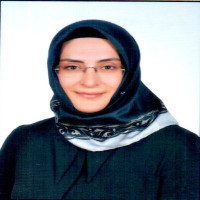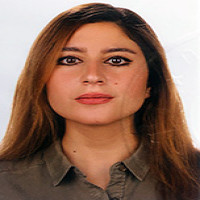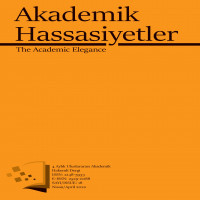Research Article
Review
Issue Reviewers






Dr. Muslu received his Bachelor's degree in Economics from Muğla University in 2001, an M.Sc. in Management and Labor Psychology from Marmara University in 2008, and a Ph.D. in Maritime Business Administration from Istanbul University in 2015. Before his academic career, he gained experience in the private sector as a ship operations manager and yacht manager.
With over nine years in academia, Dr. Muslu has focused his research on Marine Tourism Management, Maritime Management, Labor Relations, Quality Management, Human Resources Management, and other interdisciplinary perspectives. He has published over 60 papers in relevant journals and conferences.
Dr. Muslu is an Associate Professor of Maritime Business Management and Organization in the Faculty of Political Sciences at Samsun University and a visiting researcher at Southern Cross University.

Telli born in 1990, completed her undergraduate education in both international trade and banking and finance (double major degree) in Baskent University. After graduating university, she started master’s degree in the field of banking and finance in Baskent University. After taking master’s degree in 2013, started working life as a customer representative at Gedik Invest in Ankara. Then she moved to Istanbul and started to work as a tax assisstant in FSI at EY. She worked as a lecturer at Halic University, Istanbul Kultur University and Istanbul Arel University. In 2016 she started Phd programme in the field of business administration at Yildiz Technical University and graduated in 2021.







Esra Savaş, PhD, klinik psikolog ve psiko-onkolog olarak profesyonel bir kariyere sahiptir. 25 Eylül 1983 tarihinde Adapazarı, Türkiye'de doğmuştur. Türk vatandaşı olan Esra Savaş, lisans eğitimini Koç Üniversitesi Fen ve Edebiyat Fakültesi Psikoloji Bölümü'nde 2007 yılında tamamlamıştır. 2008 yılında İstanbul Üniversitesi Çapa Tıp Fakültesi'nde Psikososyal Onkoloji alanında yüksek lisans yapmış, 2014 ve 2019 yıllarında Walden Üniversitesi'nden Klinik Psikoloji alanında sırasıyla yüksek lisans ve doktora derecelerini almıştır.
Akademik ve klinik kariyerinde birçok makale yayınlamış, çeşitli üniversitelerde dersler vermiştir. Esra Savaş, İngilizce ileri seviyede, Almanca ve İspanyolca başlangıç seviyesinde, Osmanlıca ise orta üstü seviyede bilmektedir. Aktif olarak IPOS ve Türk Psiko-Onkoloji Derneği'nde üyelikleri bulunmaktadır. Çeşitli projelerde ve araştırmalarda yer alan Dr. Savaş, 2024 yılında Aarhus Üniversitesi ve Strathclyde Üniversitesi'nde ziyaretçi araştırmacı olarak çalışmıştır. Ayrıca "Kanser Sürecinde Bilişsel Davranışçı Terapi Temelli Stres Yönetim Programı" adlı kitabın yazarıdır. Psikoonkoloji alanında geniş bir eğitim ve deneyim yelpazesine sahiptir. Amerika'da yer alan Grief Recovery Institute eğitimlerini tamamlayarak Sertifikalı Yas İyileştirme Uzmanı/Yas Danışmanı ünvanını almıştır. Bu eğitimle öğrenmiş olduğu yas iyileştirme tekniklerini vefat, ilişkiler, ayrılık, taşınma, boşanma, evcil hayvan kaybı, sağlığı kaybetme, travmatik yaşantılar, işten ayrılma, maddi ya da manevi kayıp yaşayan bireylerle olan çalışmalarına aktarmıştır. Yastan İyileşme el kitabı’nın Türkiye proje editörü olarak ülkemizde yastan iyileşmek için başvurulabilecek Türkçe kaynağı alana sunmuştur.
Akademisyen olarak, Türkiye’nin farklı üniversitesinde, lisans ve yüksek lisans öğrencilerine sağlık, klinik psikoloji ve psikoterapi alanlarında dersler verip tez danışmanlığı yürütmüştür. 2023 yılı itibariyle de Yeditepe Üniversitesi’nde akademik ve araştırmaya yönelik çalışmalarına devam etmektedir.
Psikoterapi ve danışmanlık alanında; kognitif (bilişsel) terapi temelinde kanıta dayalı eklektik terapilerle kişiye özgü terapi protokolü uygulayarak kısa süreli terapi hizmeti sunmaktadır. Florya’daki ofisinde, klinik psikolojinin kaygı, depresyon, obsesyon ve uzamış yas bozukluğu alanlarında; sağlık psikolojisinin kanser, MS, ve tiroid gibi kronik hastalık alanlarında bu süreç deneyimleyen birey ve ailelerine yönelik danışmanlık, psikoeğitim ve terapi teknikleriyle bireysel ve grup desteği sunmaktadır.
Esra Savaş, PhD
Clinical Psychologist
Psychooncologist
Grief Recovery Specialist
Asst. Prof. Yeditepe University Department of Psychology
Florya Caddesi Corner Plaza, 67/4 Istanbul/Turkey
Tel:+90212 541 88 58 / +90533 438 18 11
Skype: psikolog_esra
Instagram: dr.esrasavas
Email: dresrasavas@gmail.com







ÖZGEÇMİŞ
Mehmet Gedik, 1966 yılında Samsun’da doğdu. 1973-1980 yılları arası ilk ve orta öğrenimlerini Samsun’da tamamladı.
Federal Almanya Eğitim Süreci:
• 1981-1983 MBSE – Meslek Okulu Daimler Benz Mercedes – Bremen
• 1983-1986 Meslek Okulu “Gesellenbrief (kalifikasyon)” Maschinentechnik
• 1986-1988 Meslek Lisesi FOS (Fachoberschule-Maschinentechnik)
• 1988-1990 – Makina Mühendisliği - Ön lisans / (Hochschule Bremen - Bauingenierwesen / University of Applied Scinces) Almanya-Bremen
• 1990 - 1992 – Makina Mühendisliği – Tezli Lisans / (TUHH- Technische Üniversität Harburg – Harburg) Leichtbau Technik (Bauingenierwesen) Almanya-Hamburg
• 1993 - 1996 Pedagoji Fakültesi – Tezli Lisans (Hochschule Bremen University of Applied Scinces) (Fachbereich Sozialwesen) “Almanya-Bremen
Tez Konusu: “Im Spannungsfeld von Ausländerpolitik und Migration: Probleme türkische MigrantInnen der 1., 2. Und 3. Generation in der BRD (Almanya’da Yabancılar Politikası ve Göç Kapsamında Federal Almanya’da 1. 2. ve 3. Kuşak Türk Göçmenlerin Problemleri ve Çözümleri)”
• 1994 -1999 – İktisat Fakültesi – Ön lisans & Lisans (T.C. Eskişehir Anadolu Üniversitesi) Batı Avrupa Programı Almanya-Hamburg & Köln
• 2012 - 2014 – Yüksek Lisans/MBA: Anadolu Üniversitesi, Sosyal Bilimler Enstitüsü, İşletme Anabilim Dalı, Batı Avrupa Yüksek Lisans Programı. Almanya-Köln
“Tez Konusu: Almanya’da Yaşayan Türklerin, Türkiye’nin Avrupa Birliğine Katılım Sürecine Etkisi” (Nicel Araştırma Yöntemli)
• 2015 - 2019 – Yalova Üniversitesi, Sosyal Bilimler Enstitüsü, Sosyal Hizmet Anabilim Dalı, Doktora
“Tez Konusu: Federal Almanya’da Dini Sosyal Hizmet Uygulamaları – İslimi Sosyal Hizmet Yaklaşımı”
• 2019-2021 - Aktuel – İZÜ-İstanbul Sebahattin Zaim Üniversitesi
Sağlık Bilimleri Fakültesi / Sosyal Hizmet Ana Bilim Dalı Doktor Öğretim Üyesi
• Projeler & Görevler:
Avrupa’da Müslüman Göçmen Çocukların Ana Sınıf Eğitim Müfredatları (Proje Yöneticisi)
Avrupa genelinde Ülkelerin konumlarına göre anasınıf Model Uygulamaları. (Proje Yöneticisi)
Avrupa’da Müslüman Göçmen Gençlerin Temel Eğitim Müfredatları (Proje Yöneticisi)
Avrupa’da Müslüman Göçmen Çocukların Eğim Araç ve Gereçleri/Materyalleri (Proje Yöneticisi)
Avrupa Eğitim Şuraları 1996, 2001, 2005 yılları Proje Sorumluluğu
Batı Avrupa Ülkeleri “Aile Eğitim Projeleri” (Proje Yöneticisi)
Federal Almanya / Mainz Şehri, İlahiyat Meslek Okulu Projesi (Proje Yöneticisi)
UİP-Uluslararası İlahiyat Fakülteleri öğrenci yönlendirme Projeleri (Avrupa’dan Türkiye’ye Öğrenci Yönlendirme ve Türkiye organizesi)
• Uluslararası hakemli dergilerde yayımlanan ve yayımlanacak olan makaleler:
Endüstriyel Sosyal Hizmetlerin İnsan Hakları Yaklaşımı (Perception Of Human Rights By Industrial Social Service), Mehmet Gedik, International Journal of Social Sciences, Volume. 4, Issue: 18, 2020, pp. 1-24.
TR-Dizin; Federal Almanya’da Müslüman Hastaların Dini-Manevi Temelli Sosyal Hizmet Gereksinimleri (Religious-Spiritual Based Social Work Requirements of Muslim Patients in Federal Germany), Ahi Evran Üniversitesi Sosyal Bilimler Enstitüsü Dergisi (AEÜSBED), 2021
TR-Dizin Yayınlanmak üzere; Avrupa’daki Sivil Toplum Kuruluşlarında Görevli Türk Kökenli Göçmenlerin Örgütsel Özdeşleşme Eğilimleri ile Sosyal Girişimcilik Özellikleri Arasındaki İlişki (The relationship between organizational identification deceptions of Turkish immigrants working in non-governmental organizations in Europe and Social Entrepreneurship characteristics), Bingöl Üniversitesi İktisadi ve İdari Bilimler Fakültesi Dergisi.
TR-Dizin Yayınlanmak üzere; Avrupa’daki Sivil Toplum Kuruluşlarında Görevli Türk Kökenli Göçmenlerin Örgütsel Özdeşleşme Eğilimleri ile Sosyal Girişimcilik Özellikleri Arasındaki İlişki, Bingöl Üniversitesi İktisadi ve İdari Bilimler Fakültesi Dergisi.
• Ulusal hakemli dergilerde yayımlanan makaleler:
Federal Almanya’da Sosyal Hizmet Kapsamında Müslümanlara Yönelik Palyatif Destek/Bakım Uygulamaları (Social Work in Federal Germany Palliative Support / Care Practices for Muslims) Mehmet Gedik, Yalova Sosyal Bilimler Dergisi, Yıl:9, Sayı:18, Nisan 2019, e-ISSN 2146-1406, ss.17-40
Sosyal Hizmet Uygulamaları ve “Hak Temelli”lik (Social service applications and “rights based”) Çekmece İZÜ Sosyal Bilimler Dergisi, Cilt 8: Sayı:16, 2020: 28-57
İslâm, Sekülerizm ve Geleceğin Felsefesi, Kitap Tanıtımı, Çekmece İZÜ Sosyal Bilimler Dergisi, Cilt 8: Sayı:17, 2020: 119-129
• Uluslararası Sempozyumlar:
Uluslararası Geleneksel İslâm Sanatları ve Hattat Hâmid Aytaç Sempozyumu; “İlmü’l- Cemal (Estetik İlmi) ve İnsan İlişkileri”, “İlmü’l- Cemal (Aesthetic Science)” and Human Relations, 16-18 Ekim 2020
Eko-Sistem Bağlamında Sosyal Hizmet ve Holistik Yapılandırma (Social Ministration and Holistic Structuring in The Context of Eco-System, Uluslararası Bilimsel Araştırmalar ve Yenilikçi Çalışmalar Sempozyumu ( International Symposium of Scientific Research and Innovative Studies), ISSRIS 2021, Bandırma On Yedi Eylül Üniversitesi, 22-25 Şubat 2021
USVES-Uluslararası Sosyal Bilimler ve Eğitim Bilimleri Sempozyumu, Eko-Sistem Bağlamında Sosyal Bilim ve Holistik Yapılandırma (Social Science and Holistic Configuration in The Context of Eco-System), 10-11 Nisan 2021
• Bilim Kurulu Üyeliği:
Uluslararası Geleneksel İslâm Sanatları ve Hattat Hâmid Aytaç Sempozyumu, İnternational Traditional Islamic Arts & Islamic Calligrapher Hamid Aytaç, 16-18 Ekim 2020
• Yayımlanan Kitap ve Kitap Bölümleri:
Sağlık Bilimlerinde Multidisipliner Araştırmalar - Sağlık Bilimleri, Sosyal Hizmet ve Holistik Yaklaşım, 2020, İstanbul: Efe Akademi Yayınları.
Ahsen Sosyal Hizmet Modeli İslâmî Sosyal Hizmet Yaklaşımı, 2021, İstanbul: Efe Akademi Yayınları.
İş Hayatı:
Gedik, 1993-1996 yılları arasında mühendis olarak çalışmış. 1996-1998 yılları arasında IGMG e.V. (Islamische Gemeinschaft Milli Görüş (İslam Toplumu Milli Görüş)” Köln genel merkezde Üniversiteliler Başkanlığına getirilmiştir. 1999 - 2012 IGMG e.V. Eğitimden sorumlu Genel Başkan Yardımcısı olarak görev yapmıştır. Eğitim Başkanlığı döneminde ilk kez Avrupa, Avustralya ve Kuzey Amerika kıtalarında yaşayan Türkiye kökenli göçmen çocuk ve gençlerin kimlik oluşumu ve din dersleri, anasınıf, ilköğretim, temel eğitim ve gençlik eğitim müfredatları ve bu bağlamda eğitim materyalleri çıkarılarak göçmenlerin din eğitiminde bir birliktelik sağlanmıştır. 2013 – 2015 yılları arasında IGMG e.V. çatısı altında organize olmuş, “HASENE International e.V. (HASENE Yardım Kuruluşu)”, “EMUG e.V. -Europäische Moscheebau und -Unterstützung Gemeinschaft (Avrupa Cami Yapma ve Yaşatma Birliği)”, 2015 - 2017 IGMG e.V. İrşad Başkanlığı. (Eğitim Kurumları & Hafız Eğitim Programları & UİP-Uluslararası İlahiyat Fakülteleri öğrenci organizeleri) faaliyetlerini yürütmüştür. Yine aynı yıllar arasında GENAR/Türkiye-İstanbul (Araştırma & Danışmanlık & Eğitim) kurumunda Avrupa Aile ve Eğitim Danışmanlığı görevlerinde bulunmuştur. Uzun yıllardır Avrupa genelinde “Avrupa’da sosyal hizmet ve sosyal politikalar” kapsamında (Birey, Aile ve Toplum) çerçevesinde birçok seminer ve konferanslar vermektedir. 2000 yılında Federal Almanya vatandaşı olan Gedik, Almanca ve İngilizce bilmekte, evli ve üç çocuk babasıdır.
















Kurum Bilgileri: İletişim Fakültesi, Gazetecilik Bölümü, Medya Ekonomisi Ve İşletmeciliği Anabilim Dalı Araştırma Alanları: Sosyal ve Beşeri Bilimler, Gazetecilik, İletişim Bilimleri




 Web
Web

PROF.DR. ULAŞ BAŞAR GEZGİN IN BRIEF
Prof.Dr. Ulaş Başar Gezgin is a psychologist-consultant-author with 24 years of teaching experience in Turkey, Vietnam, Thailand and Malaysia, and research experience in New Zealand (PhD), Australia (joint project) and Latin America (journalism).
EDUCATION
He completed his education at Darüşşafaka High School (1989-1996), Boğaziçi University (Psychological Counseling, Bachelor's degree, 2000; Psychological Sciences, Master's degree 2002), METU (Cognitive Sciences (specialized in psychology and linguistics, PhD, 2006) and abroad (2009, authorized to lecture at university level, Australia; master's degree in Urban Planning, at Darmstadt Technical University in 2011).
BOOKS
He has a total of 118 books, including 22 English books, 4 poetry books in English and other languages, 12 psychology and cognitive science books, 10 narrative books (novel, short story, children's story, opera libretto, fairy tale, film story, short film script, theater play), 6 Asian books, 5 narrative and literary analysis books, 7 other academic books, 20 poetry books, 10 diary and personal books, 22 translations, translation editing or edited books.
CONSULTANCY
He completed his graduation internship at Galatasaray High School.
In addition to his studies, he provides consultancy services.
IN OTHER LANGUAGES
His various works have been translated into 13 languages (Turkish, English, French, German, Spanish, Italian, Portuguese, Russian, Japanese, Vietnamese, Thai, Georgian and Azerbaijani).
WEBSITE: https://www.profdrulasbasargezgin.net






Aim & Scope
Istanbul Gelisim University Journal of Social Sciences is an international, multidisciplinary peer-reviewed journal. IGUJSS is being published twice a year.
The goal of the Journal is to establish an academic platform for the social sciences including economic and administrative sciences, Political Science and International Relations. Contributing to the production of knowledge and creation of value; be a qualified reference source in academic publishing; and giving priority to ecological, economic and social sustainability are the primary goals of the journal.
Since the day of its first issue, the editorial team of the IGUJSS has unconditionally believed that these goals can only be achieved through respect for freedom of science and freedom of speech as well as unconditional commitment to the ethical codes of research and publication.
Submitted articles are evaluated by at least two doctoral referees by double-blind method. When there is a tie, it is sent to the third referee. All appointed referees have a doctorate degree. Accepted articles are announced on our website. Book reviews are evaluated by our editorship and those deemed appropriate are published. There are no Article Processing Fees (APC) or article submission fees in this journal.
In our journal, scientific articles within the framework of the topics of ADMINISTRATIVE SCIENCES, BUSINESS, COMMUNICATION, ECONOMICS, LOGISTICS, PHILOSOPHY, POLITICAL SCIENCES, PSYCHOLOGY, PUBLIC RELATIONS, SOCIOLOGY, STATISTICS are accepted.
Scientific articles with ARCHEOLOGY, ARCHITECTURE, EDUCATION, FINE ARTS, HISTORY, INFORMATION TECHNOLOGY, LAW, LINGUISTICS and LITERATURE are not accepted.
IGUJSS publishes theoretical and empirical studies, book reviews and annotated bibliographies.
IGUJSS has an international editorial and advisory boards and publishes articles in Turkish, English, Russian, French and German languages.
Author Guidelines
Principles of Publication and Rules for Writing (PDF)
ISTANBUL GELISIM UNIVERSITY JOURNAL of SOCIAL SCIENCES
PRINCIPLES of PUBLICATION and RULES FOR WRITING (Rev. 3)
CHAPTER ONE
Purpose, Scope, Content and Definitions
Definitions:
Journal: Istanbul Gelisim University Journal of Social Sciences
Owner: Istanbul Gelisim University (IGU) Rector on behalf of founding Foundation of University,
Publication Board: Lecturers determined by the Rectorate of IGU who work in the field of Social Sciences and Humanities,
Board of Referees: Lecturers from at least five different universities who are selected by the editorial board,
Editor: Faculty members to be appointed by the Rectorate of IGU.
Assistant Editors: Lecturers from related departments to be determined by the Rectorate of IGU.
Editorial Board: Lecturers and students determined by Editor.
Purpose and Scope:
1. The purpose is to organize the procedures of publication of Journal of Social Sciences within Istanbul Gelisim University.
2. The aim of the journal is to create a common academic platform from different disciplines within the humanities such as economic and administrative sciences, political science and international relations. In addition to this, book introductions and reviews may also be included.
3. In our journal, scientific articles within the framework of the topics of ADMINISTRATIVE SCIENCES, BUSINESS, COMMUNICATION, ECONOMICS, LOGISTICS, PHILOSOPHY, POLITICAL SCIENCES, PSYCHOLOGY, PUBLIC RELATIONS, SOCIOLOGY, and STATISTICS are accepted. Scientific articles with ARCHEOLOGY, ARCHITECTURE, EDUCATION, FINE ARTS, HISTORY, INFORMATION TECHNOLOGY, LAW, LINGUISTICS and LITERATURE are not accepted. The journal is published twice a year (April and October).
4. Journal is an international peer-reviewed journal.
Content:
The articles sent to journal;
1. Should be prepared using appropriate research, methods and models specific to the field and should have the capacity to make a contribution to the field.
2. It can criticize or review a previously published article and have the qualities of research or review that present new and remarkable views in this regard.
3. Articles that discuss, criticize or explain a concept or theory, biography and the review articles, and the the translations that contribute to the scientific field can be included to journal.
4. The journal should written in the format suitable for publishing principles.
5. In addition to those listed above, book introductions and / or reviews may also be included in the journal.
CHAPTER TWO
Duties
Boards of Journal:
1. Duties of Editorial Board:
a. It meets twice a year except for extraordinary circumstances.
b. Publication Board reviews the submitted journal articles, formats and examines them, determines the experts in the field (based on thesis, publications and expertise) and sends for peer review to the referees.
c. According to the result of peer review, decides whether the article will be published or not and arranges the publication order of articles accepted by referee.
d. Decides for a special issue with absolute majority.
2. Advisory Board:
The referees will review the submitted articles in terms of method, content and authenticity and decide whether they are appropriate for the publication or not. According to the contents of the articles, this may vary in each issue.
3. Editor:
a. Provides coordination between members of the Publication Board.
b. Invites the Publication Board twice a year to conduct preliminary evaluations of the submitted articles, except for specific periods.
c. Takes editorial responsibility on behalf of the Publication Board.
d. In exceptional circumstances related to his / her duties, he / she authorizes one of his / her assistants to continue with the process.
4. Assistant Editors:
They ensure coordination between the members of the Editorial Board, monitor the peer review process and help editors in the evaluation of the reports of the referees.
5. Publication Board:
a. Assists the editor for the follow-up of articles and in technical issues.
b. Arranges the articles submitted for publication and prepares the journal for printing.
CHAPTER THREE
Evaluation
1. The articles considered suitable in terms of format and fields by the Publication Board are sent to expert referees for evaluation. If both of the referee evaluations are positive, the article will be accepted for publication. If one is positive and the other is negative, the article is sent to a third referee. The articles to be corrected for publication must be submitted by the authors within 20 days at the latest (including postal mail). The corrected text will be sent back to the referees who request the amendment, if it is deemed necessary by the Publication Board.
2. Submitted articles will be published with the final decision of the Publication Board following the approval of two referees as "publishable". The authors must consider the criticism, evaluation and correction of the referee and the Publication Board. In cases where the author does not agree, the author has the right to report them on a separate sheet with the reasons.
3. Articles that receive referee approval are published by the Editorial Board in order of submission dates, based on the subject content of the journal.
4. The Rectorate of Istanbul Gelisim University pays certain terms to the referees who fill in the Article Evaluation Form of the Journal. The referees submitting their evaluation reports within 30 days are paid 250 TL. In case of the submitting report within 60 days 125 TL will be paid. No payment will be made for evaluation reports submitted after 60 days.
5. Any articles submitted to the journal will not be returned, whether published or not.
6. The authors of articles which are not accepted will be informed through e-mail.
CHAPTER FOUR
Rules
The articles to be included in the journal must bear the rules contained in the following clauses:
1. The journal is published twice a year, in April and October, in accordance with the status of "International Peer Reviewed Journal". Where necessary, it may also be published as a Special Issue with the decision of absolute majority of the Publication Board.
2. Articles submitted to the journal must have not been published or sent for publication elsewhere.
3. The articles submitted for publication to Journal:
a. Original Research Article: A study that contributes to knowledge, refutes previous theses or introduces a new perspective, introduces new documents,
b. Review Article: A study on a controversial or ambiguous subject, criticizing the entire bibliography and reaching to a conclusion,
c. Book Introduction: A study of book introduction of current and newly published books on their own publishing areas,
d. Book Review: The journal is open to studies on the review of current and newly published books in the subject areas of journal.
e. The publication board will decide about the publication of any work.
4. The copyright of any articles published in the journal will belong to the journal. The author agrees that the copyright granted to the publication in the journal is all inclusive. There is no fee for submitting an article to our journal. The publication board sends three journals to authors in return for copyright. Republishing a published article in another publication is subject to the permission of the journal. There is no article processing fee (APCs) in our journal.
5. For translated articles sent to the journal, the permission of the author of the article and the original text is required. Translation work is also sent to the referees for approval, just like copyright studies.
6. The opinions in the articles published at the journal are the personal opinions of the authors; and they do not contain the official view of Istanbul Gelisim University and journal boards.
7. If corrections are requested from the author, such corrections should be made within 20 days at the latest and must be delivered to the Publication Board.
8. The authors must state their titles, the institutions they are employed at, their correspondence addresses, telephone numbers and e-mail addresses.
9. Any non-substantial corrections in the articles to be published may be made by Editorial Board.
10. The author(s) may withdraw the article one day before it is sent to the referees at the latest. In case if the authors want to withdraw the article for which the evaluation process had started, the evaluation costs are to be covered by the author.
11. The articles submitted to the journal are also reviewed by the plagiarism screening tool. iThenticate software is used for this purpose. Authors must upload the iThenticate report to the system during the article submission process. Reports are evaluated by the editorial and those over a certain percentage are rejected or correction is requested.
Spelling Rules:
1. Journal contains articles which have original and scientific qualities related with the content of journal as a result of evaluation of referee board.
2. Language of articles in the journal can be Turkish, English, French, German and Russian. The abbreviation of spelling and punctuation is based on the latest edition of the Turkish Language Institute's Signature Guidelines. The sentences should be clear and understandable in terms of language and expression and they should be in accordance with scientific measures.
3. Articles submitted for publication should not be more than approximately 8,000 words including summary and bibliography, except in exceptional cases.
4. The graphics used in the text should be sent in a graphics format that can be opened in Windows, the pictures should be sent in JPG format and 300 pixels resolution. The digital records of the texts and graphics (pictures, tables, attachments, etc.) sent to the journal should be sent with a CD. The originals of documents and photographs related to the topic of the article or the ones that are appropriate for the print should be selected. The name of the author should be given under the photograph and at the edge of the figure.
5. Articles containing high level of linguistic and expressive errors will not be evaluated.
6. In Latin languages, the name should be given in its original form. Names in other languages should be used in English or Turkish transliterations.
7. The articles should be uploaded to ULAKBIM DergiPark system (Address: https://dergipark.org.tr/en/pub/igusbd). The "IGUSBD Ethical Declaration and Copyright Transfer Form" must be completed and uploaded to the system at the time of submission.
Format:
1. There should be 2.5 cm spacing at the right, left, bottom and up of the page.
2. In the main body of the article, the font should be Times New Roman with 12 point, line spacing should be 1.5 lines and aligned to both sides.
3. A paragraph should start a tab (1.25cm) inside.
4. As the header information, the short name of the article should be written in all capital letters at the left. The name of the author should not be written using top or bottom headers. This will spoil the transparency of reviewing process.
5. In case of block quotations, the quotation should be inside a tab (1.25 cm). When the quotation is completed, reference should be given (source, year, page number).
Structure
The APA-style text is divided into sections. The main sections are:
Title
Abstract
Introduction
Method
Results
Discussion
Bibliography
Summary
Appendixes.
Title
1. It will be on the first page. The full title of the text should be written with capital first letters and centered.
The name of authors will be added to the next line in the same format. Finally, the authors' institutions are written in the same writing format.
2. By moving down with clicking on Enter twice, information such as the duty of author in his/her institution, any awards received, information about any studies where the article is derived from and contact information of the author will be provided from the left (not centered).
Abstract
An abstract that will not exceed 150 words (in Turkish and English, if the article is in the language of the article, then the summary in that case) must be present. The title of the abstract should be put as "Abstract". In addition, 5 English (Keywords) and 5 Turkish keywords should be provided, the word Keywords should be written from a tab (1.25 cm) inside and in Italic format.
Summary
At the end of the bibliography section of the article, a summary not to exceed 750 words (in Turkish articles should be in English / English articles should be in Turkish) it must be found. In German, French and Russian articles respectively English and the Turkish summary should also be available.
Sub Headings
1. Level: Centered, Bold, First Letters Capitalized, remaining letters not capitalized
2. Level: Left Aligned, Bold, First Letters Capitalized, remaining letters not capitalized
3. Level: A tab inside, Bold, Only the first letter of title Capitalized, remaining letters and words not capitalized, dot at the end.
4. Level: A tab inside, Italic, Only the first letter of title Capitalized, remaining letters and words not capitalized, dot at the end.
5. Level: A paragraph inside, Bold, Only the first letter of title Capitalized, remaining letters and words not capitalized, dot at the end.
Tables, Graphics, Figures and Pictures:
1. The table, graphic, figure and picture names should be placed under the table. Table, graphic, figure and picture texts and figures should be written with font size 8.
2. Table, graphic, figure and pictures should be numbered.
3. The line spacing between the texts in tables and figures should be set as 1.
Rules on In-Text References:
Type of Reference Initial reference to the work in the text Other references to the same work in the text Initial reference to the work in the text in parenthesis format Other references to the same work in the text in parenthesis format
Single author Öztaş (2014), Öztaş (2014) (Öztaş, 2014, p. 9) (Öztaş, 2014, p. 9)
Two authors Erdem and Öztaş (2015) Erdem and Öztaş (2015) (Erdem & Öztaş, 2015, p. 8) (Erdem & Öztaş, 2015, p. 8)
Three authors Altun, Şahin and Öztaş (2017) Altun et.al. (2017) (Altun, Şahin, & Öztaş, 2017. p. 5) (Altun et.al.., 2017, p. 5)
Four authors Musso, Weare, Öztaş and Loges (2006) Musso et.al. (2006) (Musso, Weare, Öztaş, & Loges, 2006, p. 4-7) (Musso et.al.., 2006, p. 4-7)
Five authors Öztaş, Myrtle, Chen, Masri and Nigbor (2002) Öztaş et.al. (2002) (Öztaş, Myrtle, Chen, Masri, & Nigbor, 2002, p. 8) (Öztaş et.al.., 2002, p. 8)
Six or more authors Öztaş et.al. (2005) Öztaş et.al. (2005) (Öztaş et.al.., 2005, p. 7) (Öztaş et.al.., 2005,
p. 7)
Author groups (as understood with abbreviation) Istanbul Gelisim University (IGU, 2018) IGU (2018) (Istanbul Gelisim University [IGU], 2018, p. 11)
(IGU, 2018, p. 11)
Author groups (without abbreviation) Istanbul Gelisim University (2018) Istanbul Gelisim University (2018) (Istanbul Gelisim University, 2018,
p. 6) (Istanbul Gelisim University, 2018, p.6)
If more than one reference is cited in the same parenthesis, the one that should be written first in bibliography should be the first.
If two or more works of the same author are quoted, the letters following the alphabetical order are added to the publication year: For example: (Arıkan, 2009a); (Arıkan, 2009b). The first of these will refer to two different works in bibliography.
If the author of the work is not mentioned, the first few words of the work are used. When referring to that work, the name of the book is written in italics and then the date is specified:
As mentioned in another source (Genel İşletme, 2017) …
As mentioned in Genel İşletme (2017)
If more than one articles with the same author surname is quoted the names of the authors should be indicated in the sentence, even if the publication years of the works are different. For example: Mehmet Ünal Şahı̇n (2015); Muzaffer Şahin (2010). Personal interviews should be mentioned in the text but not in the bibliography.
For example: (Adnan Duygun, personal interview, February 2017).
It is essential to access the primary sources in the studies, but if they could not be accessed due to circumstances, the source quoted or mentioned is specified in the submission. For example: (Cited By: Çelikbilek, 2016, p. 25); (mentioned by Karaca, 2017, pp. 32). The source information is not included in the cited or mentioned work.
Rules for Bibliography:
1. The full information of cited reference will be provided. Any works that are not cited will not be indicated in bibliography.
2. Refer to the latest edition of the work.
3. If available, the page number of the article and the volume number of the issue should be added.
4. If the DOI number is present, it must be appended to the last part of the reference.
A. Books
In the "bibliography", the surname of the author, the initials of author's first name (sometimes the initials of first two names), the year of publication (in brackets), the name of the work, publication information will be specified. Book names are written in entirely small and italic letters after the first letter of the title (except for special names).
a. Book with single author or editor
Surname of the author, Initials of the author's name. (Year). The title of the book is italic, and after the first letter (except for special names) all letters will be not capitalized. Printing Place: Publisher.
For example: AYKAÇ, B. (1999). İnsan kaynakları yönetimi ve ı̇nsan kaynaklarının stratejik planlaması. Ankara: Nobel Yayınevi.
Surname of the Editor, Initials of the Editor's name. (Ed.). (Year). The title of the book is italic, and after the first letter (except for special names) all letters will be not capitalized. Printing Place: Publisher.
For example: GÜMÜŞ, İ. (Ed.). (2017). Genel işletme. İstanbul: İstanbul Gelı̇şı̇m Ünı̇versı̇tesı̇ Yayınları
b. Books with two or more authors or editors
Surname of the first author, Initials of the first author's name. and Surname of the second author, Initials of the second author's name. (Year). The title of the book is italic, and after the first letter (except for special names) all letters will be not capitalized. Place: Publisher.
For example: KÖTEN, E., ERDOĞAN, B. (2014). Engelli gençler, sosyal dışlanma ve internet. İstanbul: İstanbul Gelı̇şı̇m Ünı̇versı̇tesı̇ Yayınları
Surname of the first author, Initials of the first author's name., Surname of the second author, Initials of the second author's name. and Surname of the third author, Initials of the third author's name. (Year). The title of the book is italic, and after the first letter (except for special names) all letters will be not capitalized. Place: Publisher
For example: KARACA, R. K., ÖZKURT, F. Z. (2017). New concepts and new conflicts in global security issues. İstanbul: İstanbul Gelı̇şı̇m Ünı̇versı̇tesı̇ Yayınları
c. Reviewed or extended editions
Surname of the author, Initials of the author's name. (Year). The title of the book is italic, and after the first letter (except for special names) all letters will be not capitalized. (Reviewed/ Extended ... Edition) Printing Place: Publisher.
For example: ALPAY, N. (2004). Türkçe sorunları kılavuzu (Reviewed
second edition). İstanbul: Metis.
ç. Books with Indefinite Authors
The title of the book is italic, and after the first letter (except for special names) all letters will be not capitalized. (Year). Place: Publisher.
For example: The 1995 NEA almanac of higher education. (1995). Washington DC: National Education Association.
d. Books with two or more volumes
Surname of the author, Initials of the author's name. (Year). The title of the book is italic, and after the first letter (except for special names) all letters will be not capitalized (Volume ....) Printing Place: Publisher.
For example: TINMAZ, H. (2015). Engelsiz Bilişim 2013 sempozyumu bildirileri (Volume 2). İstanbul: İstanbul Gelı̇şı̇m Ünı̇versı̇tesı̇ Yayınları
e. Translated Books
Surname of the author, Initials of the author's name. (Year). The title of the book is italic, and after the first letter (except for special names) all letters will be not capitalized. (Initials of Name of Translator, Surname of Translator, Trans.) Printing Place: Publisher.
For example: LUCKE, R. (2008). Girişimcinin el kitabı. (Ü. Şensoy, Trans.) İstanbul: Türkiye İş Bankası Kültür Yayınları.
f. An article in a compiled book
Surname of the author, Initials of the author's name. (Year). Title of article. The title of the book is italic, and after the first letter (except for special names) all letters will be not capitalized (pp. pages) Printing Place: Publisher.
For example: SAYAN, S. (2002). Dünya Ekonomisi ve Türkiye: Globalleşme, Liberalizasyon ve Kriz. Yerel ekonomilerin sürdürülebilir kalkınması ve Çanakkale örneği (pp. 33). Ankara: Türkiye Ekonomi Kurumu.
g. Chapter or article in Reference Books
Surname of the author, Initials of the author's name. (Year). Title of article. The title of the book is italic, and after the first letter (except for special names) all letters will be not capitalized (pp. pages) Printing Place: Publisher.
For example: TOY, H., ELMACI, D. (2015). Cumhuriyetin ilanı. Kronolojik Türkiye tarihi ansiklopedisi (pp. 6-9). İstanbul: Karma Kitaplar.
B. Articles
For Journal Articles:
Surname of the author, Initials of the author's name. (Year, and month, if any.) The title of article will be with capitalized first letter of first word, and the remaining letters will not be capitalized, if not a private name. Name of Journal and Initial Letter of Each Word in Capitalized, Volume, Italic (Issue). Page Numbers. doi: xxxxxx
For example: ÖZDEN, K., ERDOĞDU, D. & GÜL, S. (2017, October). Kriz yönetiminde üretim yönetimi stratejileri ve politikalarının kullanılmasıyla ilgili bir alan araştırması. İstanbul Gelişim Üniversitesi Sosyal Bilimler Dergisi, Volume 4 (2), 23-50. doi:10.17336/igusbd.348761
C. Other Resources
a. Movie
Surname of the Director, Initials of the Director's name. (Director). (Year). Name of the Movie in Italic format. Production city: Name of production company.
For example: TYLDUM, M. (Director). (2014). The Imitation Game. USA: Black Bear Pictures.
b. Internet Sources
Surname of the author, Initials of the author's name. (Date of publication of article). The title of article will be italic and with capitalized first letter of first word, and the remaining letters will not be capitalized, if not a private name. Date of Access: Day Month Year, link to the article.
For example: Yüksek Öğretim Kurulu (YÖK) (10.01.2018) Akademisyenlere yurt dışı imkanı. Date of Access: 15.01.2018, https://www.cnnturk.com/turkiye/akademisyenlere-yurt-disi-imkani
c. Unpublished Graduate Theses
Surname of the author, Initials of the author's name. (Year). The title of thesis will be italic and with capitalized first letter of first word, and the remaining letters will not be capitalized, if not a private name (Unpublished Graduate Thesis). Name of Institution, Location of Institution.
For example: SELIMLER, H. (2006). Türk bankacılık sektöründe sorunlu kredilerin varlık yönetim şirketlerince tasfiyesi, seçilmiş ülkeler ve Türkiye uygulaması (Unpublished Doctoral Thesis). Marmara Üniversitesi Bankacılık ve Sigortacılık Enstitüsü, İstanbul.
Ethical Principles and Publication Policy
PUBLICATION ETHICS AND PUBLICATION POLICY
Istanbul Gelisim University Journal of Social Sciences (IGUJSS) is an international peer-reviewed journal by at least two international reviewers who are specialized in the area. IGUJSS aims to publish original articles interdisciplinary to form a common academic community. The journal also aims to contribute to produce academic value and knowledge in the interdisciplinary areas. The journal is published two times a year (April and October), but additional issues may be published. Papers are welcomed after a strict peer-reviewed process. The papers are only taken into account in review process in terms of their significance, uniqueness, readability, contribution, signification, relevance, and language. Plagiarism is not acceptable in IGUJSS, thus, an electronic plagiarism programs (iThenticate, Turnitin and intihal.net) are used for evaluating the papers’ originality. The decision process is onto editors and the process contain acceptance, acceptance with revisions, or rejection. The publication ethics of the IGUJSS conform to the international ethical standards for involved parties including authors, editors, and peer reviewers.
IGUJSS welcome following disciplines: ADMINISTRATIVE SCIENCES, BUSINESS, COMMUNICATION, ECONOMICS, LOGISTICS, PHILOSOPHY, POLITICAL SCIENCES, PSYCHOLOGY, PUBLIC RELATIONS, SOCIOLOGY, and STATISTICS.
IGUJSS’s registered editors and reviewers are responsible for ensuring the quality of the published papers and the contribution to the academia fully committed to fulfilling the ethical responsibilities that are set by COPE (http://publicationethics.org/resources/guidelines.)
Section A: Publication and authorship
1. The double blind method is applied.
2. All submitted papers are under strict peer-review process by at least two international reviewers who are specialized in the area.
3. The papers are only taken into account in review process in terms of their significance, uniqueness, readability, contribution, signification, relevance, and language.,
4. It is not possible to re-review rejected papers.
5. The decision process contains acceptance, acceptance with revisions, or rejection.
6. If an author gets revision or resubmission for the paper, it is not certain that the revised version will be accepted or published.
7. The paper acceptance is constrained by such legal requirements as copyright infringement and plagiarism.
8. Submitting the same paper to different journals is not acceptable.
Section B: Authors’ responsibilities
1. All Authors mentioned in the paper must have significantly contributed to the research. All authors must contribute to the research.
2. All authors must confirm that their research is original. Plagiarism is not acceptable.
3. All authors must confirm that the paper has not been published in any other journals.
4. All authors must report any mistakes that are in the published paper.
5. All authors must confirm that the paper has not been submitted for other journals’ review process.
6. All authors must provide corrections and retractions of the paper.
7. All authors must state that all relevant data that are in mentioned in the paper are genuine and real.
8. All authors must inform the Editors about the conflict of interest.
9. All authors must participate in the peer-review process.
10. All authors must cite the sources that are used in the research.
Section C: Reviewers’ responsibilities
1. Reviewers must define non-cited and relevant sources in the paper.
2. Reviewers must mind that all papers’ information is confidential.
3. Reviews should be objective.
4. Reviewers must notify the Editors about any similarity in the paper among other papers.
5. Reviewers must declare their opinions regarding supporting objectives.
6. Reviewers must be equal to all authors, but if there are conflicts of interest resulting from personal views, the reviewer should not review the paper.
Section D: Editors’ responsibilities
1. All Editors must guarantee the integrity of the academic level and the papers’ quality.
2. All Editors should be determined about their decisions and should not overturn the decisions.
3. All Editors should mind the confidentiality of the reviewers.
4. All Editors are responsible for the quality of the submitted papers’ content.
5. All Editors must mind the authors and the regarding readers’ requests.
6. All Editors must make literal corrections if it is necessary and publish these corrections.
7. All Editors should be clear and controllable about the funding sources that contribute to the journal.
8. All Editors should make their decisions based on the uniqueness, clearness, relevance, and language of the submitted research.
9. All Editors must be certain that all published researches correspond to the international guidelines.
10. All Editors are responsible for rejecting or accepting the papers.
11. All Editors should involve in any malpractice in the journal or the process of publishing and also should take action.
12. All Editors should be transparent in accepting papers and should have proof to present.
13. All Editors must ensure that there are no conflicts of interest between editors, paper authors, reviewers, and editorial board.
14. All Editors should be selective in the process of accepting the papers.
Price Policy
There are no Article Processing Charges (APCs) or article submission charges in our journal.
![]() Attribution-NonCommercial-NoDerivatives 4.0 International (CC BY-NC-ND 4.0)
Attribution-NonCommercial-NoDerivatives 4.0 International (CC BY-NC-ND 4.0)
